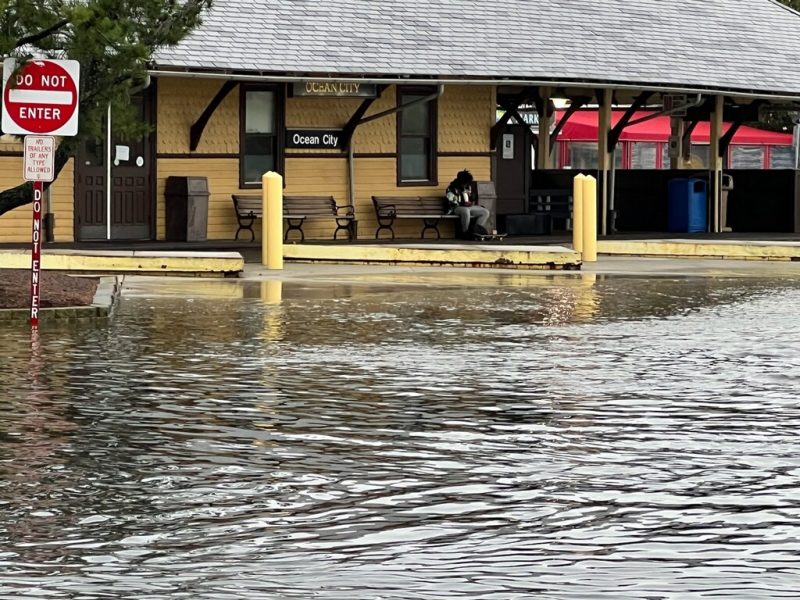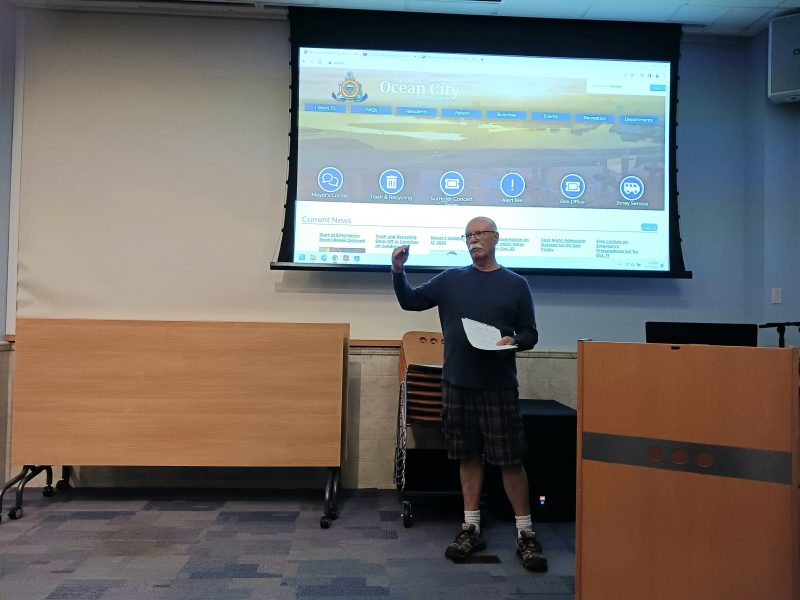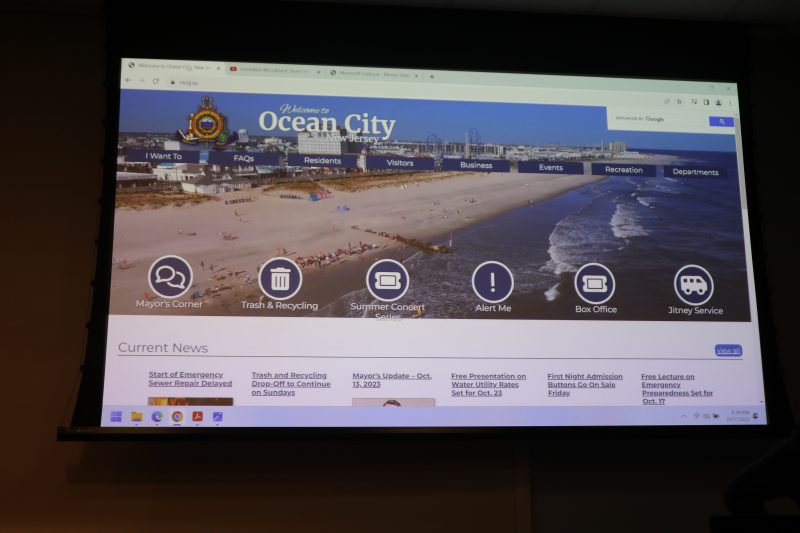 By MADDY VITALE
By MADDY VITALE
The many benefits of living near the water certainly outweigh the negatives, judging by the fact that Ocean City has about 11,000 year-round residents and tens of thousands of visitors each year.
But when there are coastal storms and other weather events, locals and vacationers need to be prepared.
That means they need to know the timing of the storm and if in fact there could be a threat of flooding at their homes or if their vehicles need to be moved.
Ocean City Emergency Management Director Frank Donato gave a presentation Tuesday night about how to be prepared for any kind of weather, from winter and summer storms to hurricanes and even tornados.
“It’s very important for you to have a live weather app on your phone. Keeping an eye on the radar is essential,” Donato told the audience members. “It is important to have some form of weather service.”

Tropical Storm Ophelia leaves parts of Ocean City flooded on Sept. 23.
Donato urged residents to sign up for the city’s alert system on the website
www.ocnj.us/oem.
The website gives people the option of tailoring what alerts they would like to receive.
“Our most common threat is tidal flooding. The tidal flooding and nor’easters are our biggest threats and the most common weather announcements out there,” Donato said of the alerts.
During his presentation at the Ocean City library, he also explained full moon cycles and how to read tide charts.
He also pointed out that on the city’s website under the "Emergency Management" tab there is a page dedicated to the biggest storms in recent history, dating to the 1944 hurricane up to 2012 with Hurricane Sandy.
In addition, there are other storms listed on the page that resulted in moderate to minor flooding, with the most recent one from Sept. 23.
Donato said that many things have changed since Hurricane Sandy that have helped lessen flooding on the island. The beaches have been replenished in an ongoing partnership with the U.S. Army Corps of Engineers. There are also pumping stations in town that mitigate the flooding. And roadways have been elevated.

Environmental Commission Chairman Rick Bernardini gives remarks before the presentation begins.
The event, which was sponsored by the Ocean City Environmental Commission, was the first since 2017.
Commission Chairman Rick Bernardini said he felt it was definitely important to have another one, considering the many weather events over the years.
During the presentation, local residents asked questions mostly pertaining to flooding, the full moon and other topics.
Bernardini also asked Donato a question.
“With the flooding that we usually have, how many cars do we usually lose?” he asked.
“A couple dozen each year, for sure,” Donato responded.
Donato said that it was during the Sept. 23 tropical storm, called Ophelia, that Ocean City experienced significant flooding, especially in the Merion Park neighborhood.
A similar high tide brought flooding in June to the same neighborhood and other areas of town, resulting in five or six cars being towed away.
Donato said it seems that during the summer season, when there are storms, more cars are lost. He noted that is another important reason why anyone who stays in the resort, even for vacation, should sign up for the city weather alerts.

The Ocean City website offers ways to receive information about storms.
“Being informed, knowing where to get information is half the battle,” Donato said. “Mayor (Jay) Gillian had the foresight to have the message system to get information out in times of emergencies.”
The city uses the National Weather Service when it puts out its advisories, watches and warnings.
There are two areas of town with tide gauges, one at the Ninth Street Bridge and the other at the Bayside Center.
The gauges give indications of how long it will take for the tidal waters to reach the other sides of the island.
It would take about 40 minutes to reach Merion Park, which is located on the south end of town, Donato noted.
“In the summer, thunderstorms are our biggest threat,” Donato said. “You have to keep your eye on them and look at them on the radar and see them coming.”
For more information about Ocean City, visit ocnj.us.

Here is a tide chart.
 By MADDY VITALE
The many benefits of living near the water certainly outweigh the negatives, judging by the fact that Ocean City has about 11,000 year-round residents and tens of thousands of visitors each year.
But when there are coastal storms and other weather events, locals and vacationers need to be prepared.
That means they need to know the timing of the storm and if in fact there could be a threat of flooding at their homes or if their vehicles need to be moved.
Ocean City Emergency Management Director Frank Donato gave a presentation Tuesday night about how to be prepared for any kind of weather, from winter and summer storms to hurricanes and even tornados.
“It’s very important for you to have a live weather app on your phone. Keeping an eye on the radar is essential,” Donato told the audience members. “It is important to have some form of weather service.”
By MADDY VITALE
The many benefits of living near the water certainly outweigh the negatives, judging by the fact that Ocean City has about 11,000 year-round residents and tens of thousands of visitors each year.
But when there are coastal storms and other weather events, locals and vacationers need to be prepared.
That means they need to know the timing of the storm and if in fact there could be a threat of flooding at their homes or if their vehicles need to be moved.
Ocean City Emergency Management Director Frank Donato gave a presentation Tuesday night about how to be prepared for any kind of weather, from winter and summer storms to hurricanes and even tornados.
“It’s very important for you to have a live weather app on your phone. Keeping an eye on the radar is essential,” Donato told the audience members. “It is important to have some form of weather service.”
 Tropical Storm Ophelia leaves parts of Ocean City flooded on Sept. 23.
Donato urged residents to sign up for the city’s alert system on the website www.ocnj.us/oem.
The website gives people the option of tailoring what alerts they would like to receive.
“Our most common threat is tidal flooding. The tidal flooding and nor’easters are our biggest threats and the most common weather announcements out there,” Donato said of the alerts.
During his presentation at the Ocean City library, he also explained full moon cycles and how to read tide charts.
He also pointed out that on the city’s website under the "Emergency Management" tab there is a page dedicated to the biggest storms in recent history, dating to the 1944 hurricane up to 2012 with Hurricane Sandy.
In addition, there are other storms listed on the page that resulted in moderate to minor flooding, with the most recent one from Sept. 23.
Donato said that many things have changed since Hurricane Sandy that have helped lessen flooding on the island. The beaches have been replenished in an ongoing partnership with the U.S. Army Corps of Engineers. There are also pumping stations in town that mitigate the flooding. And roadways have been elevated.
Tropical Storm Ophelia leaves parts of Ocean City flooded on Sept. 23.
Donato urged residents to sign up for the city’s alert system on the website www.ocnj.us/oem.
The website gives people the option of tailoring what alerts they would like to receive.
“Our most common threat is tidal flooding. The tidal flooding and nor’easters are our biggest threats and the most common weather announcements out there,” Donato said of the alerts.
During his presentation at the Ocean City library, he also explained full moon cycles and how to read tide charts.
He also pointed out that on the city’s website under the "Emergency Management" tab there is a page dedicated to the biggest storms in recent history, dating to the 1944 hurricane up to 2012 with Hurricane Sandy.
In addition, there are other storms listed on the page that resulted in moderate to minor flooding, with the most recent one from Sept. 23.
Donato said that many things have changed since Hurricane Sandy that have helped lessen flooding on the island. The beaches have been replenished in an ongoing partnership with the U.S. Army Corps of Engineers. There are also pumping stations in town that mitigate the flooding. And roadways have been elevated.
 Environmental Commission Chairman Rick Bernardini gives remarks before the presentation begins.
The event, which was sponsored by the Ocean City Environmental Commission, was the first since 2017.
Commission Chairman Rick Bernardini said he felt it was definitely important to have another one, considering the many weather events over the years.
During the presentation, local residents asked questions mostly pertaining to flooding, the full moon and other topics.
Bernardini also asked Donato a question.
“With the flooding that we usually have, how many cars do we usually lose?” he asked.
“A couple dozen each year, for sure,” Donato responded.
Donato said that it was during the Sept. 23 tropical storm, called Ophelia, that Ocean City experienced significant flooding, especially in the Merion Park neighborhood.
A similar high tide brought flooding in June to the same neighborhood and other areas of town, resulting in five or six cars being towed away.
Donato said it seems that during the summer season, when there are storms, more cars are lost. He noted that is another important reason why anyone who stays in the resort, even for vacation, should sign up for the city weather alerts.
Environmental Commission Chairman Rick Bernardini gives remarks before the presentation begins.
The event, which was sponsored by the Ocean City Environmental Commission, was the first since 2017.
Commission Chairman Rick Bernardini said he felt it was definitely important to have another one, considering the many weather events over the years.
During the presentation, local residents asked questions mostly pertaining to flooding, the full moon and other topics.
Bernardini also asked Donato a question.
“With the flooding that we usually have, how many cars do we usually lose?” he asked.
“A couple dozen each year, for sure,” Donato responded.
Donato said that it was during the Sept. 23 tropical storm, called Ophelia, that Ocean City experienced significant flooding, especially in the Merion Park neighborhood.
A similar high tide brought flooding in June to the same neighborhood and other areas of town, resulting in five or six cars being towed away.
Donato said it seems that during the summer season, when there are storms, more cars are lost. He noted that is another important reason why anyone who stays in the resort, even for vacation, should sign up for the city weather alerts.
 The Ocean City website offers ways to receive information about storms.
“Being informed, knowing where to get information is half the battle,” Donato said. “Mayor (Jay) Gillian had the foresight to have the message system to get information out in times of emergencies.”
The city uses the National Weather Service when it puts out its advisories, watches and warnings.
There are two areas of town with tide gauges, one at the Ninth Street Bridge and the other at the Bayside Center.
The gauges give indications of how long it will take for the tidal waters to reach the other sides of the island.
It would take about 40 minutes to reach Merion Park, which is located on the south end of town, Donato noted.
“In the summer, thunderstorms are our biggest threat,” Donato said. “You have to keep your eye on them and look at them on the radar and see them coming.”
For more information about Ocean City, visit ocnj.us.
The Ocean City website offers ways to receive information about storms.
“Being informed, knowing where to get information is half the battle,” Donato said. “Mayor (Jay) Gillian had the foresight to have the message system to get information out in times of emergencies.”
The city uses the National Weather Service when it puts out its advisories, watches and warnings.
There are two areas of town with tide gauges, one at the Ninth Street Bridge and the other at the Bayside Center.
The gauges give indications of how long it will take for the tidal waters to reach the other sides of the island.
It would take about 40 minutes to reach Merion Park, which is located on the south end of town, Donato noted.
“In the summer, thunderstorms are our biggest threat,” Donato said. “You have to keep your eye on them and look at them on the radar and see them coming.”
For more information about Ocean City, visit ocnj.us.
 Here is a tide chart.
Here is a tide chart.